black willow
Family
SalicaceaeScientific Name
Salix nigraSynonyms (former Scientific Names):
Salix denudata
Salix purshiana
Salix falcata
Salix ludoviciana
Salix ambigua
Salix dubia
Salix flavovirens
Salix ligustrina
Habit
Black willow grows to be a small to medium sized tree. It can grow up to 50 feet in height and one foot in diameter. It is often found near bodies of water with many of its branches hanging over the water.
Leaves
The leaves of black willow are lanceolate in shape, and 3 to 6 inches long. The edges are serrated and the leaves are pinnately veined. The leaves are dark green and shiny on the top, and light green on the bottom.
Identifying Characteristics
Black willow is distinguished by its long, thin, finely toothed, pointed leaves.
Flower Seed Head
The flowers of black willow are small and are borne on catkins. The catkins are one to three inches long. The actual flowers are tiny and green. They are present from May to June.
Seed Fruit
The fruit of black willow is cone shaped. It contains many small, cottony seeds. The capsules split on maturity, from June to July.
Where Found
Black willow is found throughout the eastern United States, as far west as Nebraska and Texas.
Growth Habit
woody bush or tree
Thorns or Spines
not present
Approximate Flower Diameter
dime
Dominant Flower Color
green
Flower Symmetry
bilateral symmetry
Leaf Hairs
Varies:
has hairs,
no hairs
Leaf Arrangement
alternate
Leaf Margin
serrated
Leaf Structure
simple
Leaf Stalk
shorter than leaf
Stem Hairs
no hairs
Stem Cross Section
round or oval
Milky Sap
not present
Life Cycle
perennial
Ochrea
not present
Plant Type
Tree









